#Altmetric
Explore tagged Tumblr posts
Text
Twitter turbulences and their impact on Altmetric scores: a follow-up
Pablo de Castro, Open Access Advocacy Librarian at U Strathclyde
As stated in the previous post on this topic a month and a half ago, we continue to look into this issue of the possible impact of the "twitter instability" on Altmetric scores as a proxy for social impact of research.
The bad news first: the Altmetric score for the March 2023 paper in the European Journal of Human Genetics that the previous post was looking into has barely climbed despite all the media attention. As of May 6th, 2023 the score for this paper is "just" 124. This is of course one order of magnitude higher than it was a month and a half ago, but it's still rather low (see the good news bit below). The silver lining is that all the references in the news seem to have been incorporated to the score – there's 14 of them recorded in the Altmetric page.

The good news is that some publications are still able to grow very high Altmetric scores quite quickly. See for instance this PLoS Genetics paper "Imputed genomes and haplotype-based analyses of the Picts of early medieval Scotland reveal fine-scale relatedness between Iron Age, early medieval and the modern people of the UK" by A Morez (Liverpool John Moores University) et al at.
This paper, also on the topic of paleogenetics/ancient DNA and also with a key input from the University of Aberdeen (by Linus Girdland-Flink and his team), was only published on Apr 27th, 2023, i.e. just over a week ago. Its Altmetric score as of May 6th is 1,363, resulting from 166 identified mentions in news outlets and 152 tweeters. This means first and foremost that Altmetric scores seem to remain a reliable proxy for social impact of research (though the exploration continues).

It also means that the authors of this more recent paper in PLoS Genetics have probably taken a more proactive approach to dissemination within a closely-knit international community in the discipline. The journal of choice also plays an important role here – the Public Library of Science is an Open Access publisher and pioneered the adoption of article-level metrics quite a long time ago. On top of all this, the publication has been picked by AlphaGalileo, who have published and interview with the first author at Liverpool John Moores University.
A short introductory talk "Exploring Prehistory with Ancient DNA" delivered within the Aberdeen Little Lectures by Linus Girdland-Flink back in 2020 is available on YouTube, proving the point on proactiveness and international collaborative work in the discipline.
2 notes
·
View notes
Text

From Altmetrics for information professionals by Kim Holmberg, from 2016.
This hits different in 2023, don't it.
2 notes
·
View notes
Text
The media coverage on this has been absolutely bonkers. It might be our most successful piece ever in the media, although the Altmetrics don't reflect it.
There's a very good chance the frogs appear in a newspaper near you! If you find them in the wild, please send me a photo and/or physical copy of the paper!! I would be extremely grateful!
Also if you hear about it on the radio, please let me know when and where (which channel)!
Meet the seven new frog species we just named after iconic Star Trek captains!
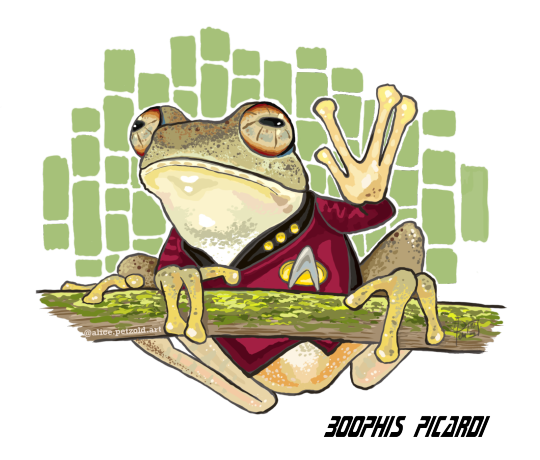
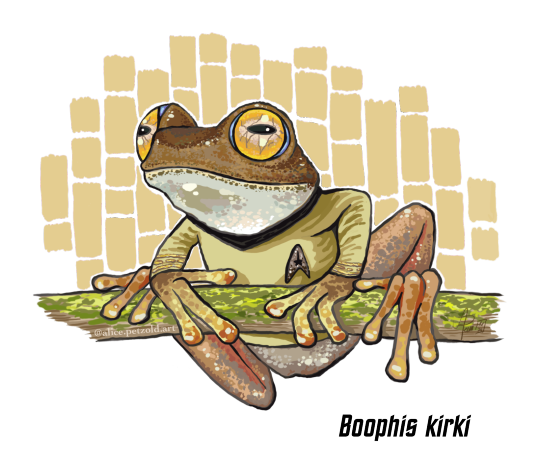
Artwork by A. Petzold, CC BY-ND 4.0
At the right time of year along rushing streams in the humid rainforests that stretch the length of Madagascar's eastern and northern mountain ridges, otherworldly trills of piercing whistles can be heard.
Are they birds? Insects? Communicator beeps? Tricorder noises?
No, they're little treefrogs!
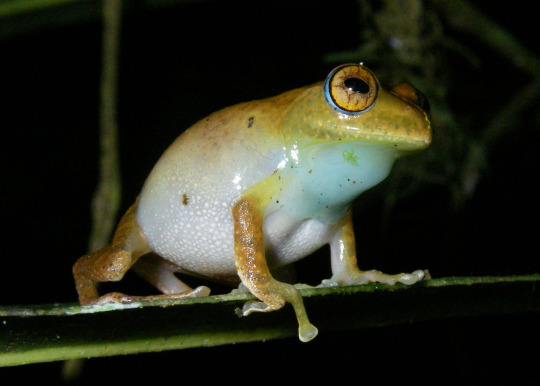
Boophis janewayae. Photo by M. Vences, CC BY-SA 4.0
Until recently, we thought all of the populations of these little brown frogs across the island were one widespread species, Boophis marojezensis, described in 1994. But genetics in the early 2000s and 2010s showed that there were several species here, not just one.
Now my colleagues and I have shown that they are in fact eight separate species, each with unique calls!
These whistling sounds reminded us so much of Star Trek sound effects that we decided to name the seven new species after Star Trek captains: Boophis kirki, B. picardi, B. janewayae, B. siskoi, B. pikei, B. archeri, and B. burnhamae.
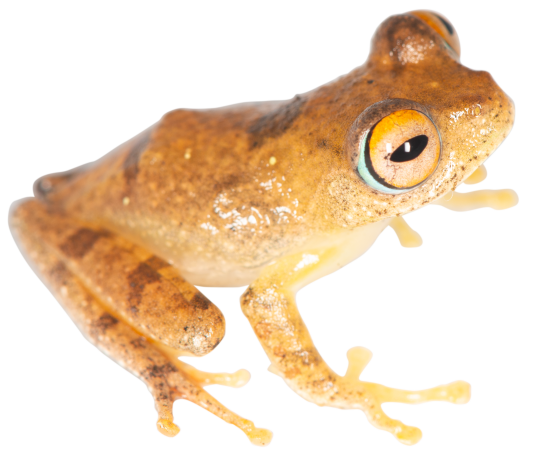



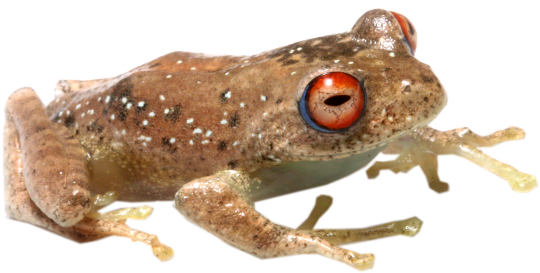


Photos of all new species described by Vences et al. 2024. CC BY-SA 4.0
I subtly and not-so-subtly built some Star Trek references into the paper, but probably the best one is this one:
'Finding these frogs sometimes requires considerable trekking; pursuing strange new calls, to seek out new frogs in new forests; boldly going where no herpetologist has gone before.'
— Vences et al. 2024
There’s a real sense of scientific discovery and exploration here, which we think is in the spirit of Star Trek.
Of course, it doesn't hurt that there are at least two Trekkies amongst the authors (including yours truly). As fans of Star Trek, we are also just pleased to dedicate these new species to the characters who have inspired and entertained us over the decades.
On a personal note, this marks a milestone for me, as it means I have now described over 100 frog species! I am very pleased that the 100th is Captain Janeway's Bright-eyed Frog, Boophis janewayae (if you count them in order of appearance in the paper)—she is probably my favourite captain, and I really love Star Trek: Voyager.
You can read more about the discovery of these new species on my website! You can also read the Open Access paper published in Vertebrate Zoology here.
8K notes
·
View notes
Text
David Kim, David McCalman & Dan Fisher
4791 Accesses
23 Citations
1 Altmetric
Explore all metrics
Abstract
Many employees with strong religious convictions find themselves living in two separate worlds: the sacred private world of family and church where they can express their faith freely and the secular public world where religious expression is strongly discouraged. We examine the origins of sacred/secular divide, and show how this division is an outcome of modernism replacing Christianity as the dominant worldview in western society. Next, we make the case that guiding assumptions (or faith) is inherent in every worldview, system of thought, or religion and also show that scientific reason can never be a comprehensive or totalizing meaning system, particularly in the realm of ethics. The underlying assumptions of the sacred/secular divide are seriously questioned which has implications for employees who desire to integrate faith and career. Finally, we offer possibilities for individuals and corporate entities to integrate the personal and sacred with the institutional and secular.
0 notes
Photo

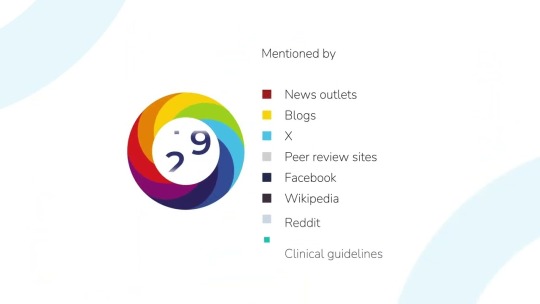


2024年12月04日 16時21分 Blueskyが論文影響力可視化サービス「Altmetric」の指標に採用される
科学研究論文のオンライン上での影響力がどれぐらいなのかを示す指標「オルトメトリクス(Altmetrics)」の測定サービスである「Alemetric」が、測定対象にSNS「Bluesky」を追加したことを発表しました。Blueskyに投稿されている研究関連のやりとりを体系的に把握・分析するプラットフォームはAltmetricが初だとのことです。
Altmetric introduces Bluesky as a new social media tracking source - Altmetric https://www.altmetric.com/altmetric-news/altmetric-introduces-bluesky-as-a-new-social-media-tracking-source/
Altmetric Is Now Tracking Bluesky Mentions! - Bluesky https://bsky.social/about/blog/12-03-2024-altmetric
Altmetric adds Bluesky social media as a research attention source - Digital Science https://www.digital-science.com/news/altmetric-adds-bluesky-social-media-as-a-research-attention-source/
Bluesky in Altmetric - YouTube
「発表された論文がどれぐらいの影響力をもたらしたのか」を測る方法は複数あって、最も手堅い方法としては「被引用数を調べる」という方法があります。
2022年に最も引用されたAI論文100本の分析結果、Googleとアメリカが強い中で勢いに乗っているのは? - GIGAZINE
また、学術誌の影響力の大小を示す指標として、学術誌ごとに掲載された論文の被引用数を平均した「インパクトファクター」があり、研究者の貢献度を示す指標として、書いた論文の本数と被引用数をもとにした「h指数(h-index)」があります。
「オルトメトリクス」は、論文の影響力を「他の論文にどれぐらい引用されたか」ではなく、ネット上での閲覧数や言及数などで測定した指標です。測定を行うツールやプラットフォームは複数あり、その中の1つが「Altmetric」です。
Altmetricは��れまでWikipediaやX、Reddit、Facebookを測定対象としてきました。
そこに、新たにBlueskyが加わることになります。
スコアはXと同じように「オリジナル投稿に1ポイント、再投稿は0.85ポイント」でカウントされ、再投稿が200回行われるとスコア上限が設定されます。
アカウントの投稿頻度や、特定の学術誌についてのみ投稿していないかどうかという点も考慮されるとのこと。
Altmetricによると、2024年10月25日時点でBlueskyには論文への言及を含む投稿が39万5000件あったとのことです。
実際にAltmetricのデータが見られる事例は以下。
Life history in Caenorhabditis elegans: from molecular genetics to evolutionary ecology | Genetics | Oxford Academic https://academic.oup.com/genetics/article/228/3/iyae151/7826457
ページ右側にCITATION(引用数)、VIEWS(閲覧数)と並んでAltmetricのスコアが示されています。
Alemetricのアイコンをクリックすると、オルトメトリクスが表示され、XとBlueskyで言及されていることが示されています。
Altmetric – Life history in Caenorhabditis elegans: from molecular genetics to evolutionary ecology https://oxfordjournals.altmetric.com/details/169499659
Blueskyのユーザー数は2024年11月時点で2000万人を突破しています。
ついにBlueskyのユーザー数が2000万人を突破、2000万人記念アップデートもあり - GIGAZINE
また、多くの科学者がXからBlueskyに移住していることが明らかになっており、調べによると、研究者の22%以上が他のSNSよりもBlueskyを支持しているとのこと。
大量の科学者がX(旧Twitter)からBlueskyに移住している - GIGAZINE
研究者が多く集っているのであれば、Blueskyでは科学論文に関連した言及の割合がXより高くなることが考えられ、新たな洞察が得られると期待されています。
この記事のタイトルとURLをコピーする
・関連記事 論文の価値をゆがめる「論文の被引用数稼ぎ」の実情とは? - GIGAZINE
中国の科学者が「自国の論文を引用しまくる」のが科学の国際ランキングをゆがめているとの指摘 - GIGAZINE
著名神経科学者でアメリカ国立老化研究所の部門長でもあるエリーザー・マスリアの論文に画像偽造の疑い、アルツハイマー病とパーキンソン病で世界中で引用されまくる論文に疑惑 - GIGAZINE
科学の信用を失墜させかねない「不正論文の実態」とは? - GIGAZINE
・関連コンテンツ
Twitterがツイートへの「反対票」ボタンの搭載を拡大へ
大量の科学者がX(旧Twitter)からBlueskyに移住している
ハッシュタグ付きのツイートは「好意的な反応を得られない」ことがTwitter分析レポートで明らかに
イーロン・マスク買収後のX(Twitter)から科学者がどんどん離れている、いったいなぜ?
「Twitterの主流派は政治的な影響力を競い活動する人々ではない」と研究によって判明
Twitterが複数ツイートをまとめるスレッド機能を公開、実際に使ってみた
Twitterがツイートに対する「返信」をランク付けするなど、「Twitterでの会話」の仕様が変更へ
「Facebookの寿命はあと4年しかない」とアメリカの研究者が予想
(Blueskyが論文影響力可視化サービス「Altmetric」の指標に採用される - GIGAZINEから)
1 note
·
View note
Text
Review of the COVID-19 Pandemic on the Urology Literature

Review of the COVID-19 Pandemic on the Urology Literature in Biomedical Journal of Scientific & Technical Research
Introduction: On March 11, 2020, the World Health Organization declared COVID-19 a global pandemic. Since then, our lives have changed in ways we could have never imagined. Multiple countries instituted “stay at home” quarantines, some of which continue to be in place today. The lives of healthcare workers have changed significantly, both in terms of clinical work and research. We reviewed the exisiting literature surrounding the COVID-19 pandemic to examine if there was a significant impact on the citation of recent urologic articles and the time from submission to article publication. Methods: Using the Journal Citation Reports, we reviewed the 15 urology journals with the highest impact factors in 2019 and sorted papers by whether they were related to COVID-19 or not. Articles were characterized by country of origin, type of article, subspecialty of urology, and time to publication. The Altmetric Attention Score (AAS), a metric of article dissemination, and citation count was also compared for COVID-19 versus non-COVID-19 related articles. Results: The average AAS score of COVID-19 articles was significantly higher than non-COVID-19 articles (22.5 vs 7.0, p<0.001). The highest average AAS was observed in the second quarter of 2020. COVID-19 articles had more citations than non-COVID-19 articles (7.5 vs 0.9, p<0.001). The median time between submission and publication was 52 days, compared to 164 days reported for publications in a comparable field prior to COVID-19. Conclusion: Urology articles related to COVID-19 objectively garnered more attention than articles not related to COVID-19. The publication timeline from submission to acceptance was significantly faster during the COVID-19 pandemic.
For more articles in Journals on Biomedical Sciences click here bjstr
Follow on Twitter : https://twitter.com/Biomedres01 Follow on Blogger : https://biomedres01.blogspot.com/ Like Our Pins On : https://www.pinterest.com/biomedres/
#Journals on Neuro Imaging#Scientific Research Articles on Biomedical#Biomedical Science Articles#Journal of Biomedical Research#Journal of Biomedical Research and Review
0 notes
Text
Also, researchers can use Altmetric to track down shares in places like Twitter and see what people have to say about their work. In the pre-Twitter-demise days I used to check on my most popular pair and sneakily eavesdrop on what people were saying about it.
should be able to leave kudos on scientific studies. i liked your paper dude keep at it
108K notes
·
View notes
Text
The role and value of science in shark conservation advocacy | Scientific Reports (nature.com)
The role and value of science in shark conservation advocacy | Scientific Reports (nature.com)
The role and value of science in shark conservation advocacy
David S. Shiffman,
Catherine C. Macdonald,
S. Scott Wallace &
Nicholas K. Dulvy
Scientific Reports volume 11, Article number: 16626 (2021) Cite this article
9670 Accesses
7 Citations
289 Altmetric
Metrics
0 notes
Text
Twitter turbulences and their impact on Altmetric scores
Pablo de Castro, Open Access Advocacy Librarian at U Strathclyde
This is the first post in a series of informal musings on public ownership of scholarly comms-related infrastructure. This topic is very dear to the staff working in the domain at public research-performing organisations – including at U Strathclyde – and the series may subsequently see input from different members of the institutional Scholarly Publications and Research Data (SPRD) team.

Just a few days ago – on Fri Mar 17th, 2023 – news emerged in mainstream media on a ground-breaking research work conducted in Aberdeen and Edinburgh about a breast cancer-inducing gene (BRCA1) that could be traced back to some distant Orkney ancestor. This was a particularly inspiring piece of news not just because it was coming from Scotland but – mainly – because of its social implications in terms of ‘precision medicine’ application (Iceland came of course instantly to mind).
The news was very good – not the most frequent case these days unfortunately – and subsequently featured in lots of mainstream outlets beyond the usual university websites and niche research forums. One got to hear about it on BBC Radio 4 but there were pieces about it on the BBC and STV websites, The Guardian, the Aberdonian Press and Journal, the National and the Daily Mail among many other sources. Upon learning of the news – not something one should be particularly proud of given this specific genetics research work seems to have been going on for 25 years – the logical next step was to check the (Open Access) journal article in the European Journal of Human Genetics where the research findings were reported that gave rise to the hype.
The article web page contained a link to its Altmetric score – which one automatically assumed would eventually become massive same as for other high-impact research outputs in the recent past. Eventually because at the time of checking (the next day after the widespread media reporting) the score was just 15. So one kept the URL for the Altmetric page for the article in order to revisit it every week or so and witness the expected steep increase.
However, this steep increase has not materialised – or at least it has not five days after the news first broke out. This is bizarre. An Altmetric score of 17 for a paper that has featured essentially everywhere? Very strange. One could argue that it may be the news channels’ fault if they haven’t included the DOI of the article in the text or its associated metadata for their pieces, but this doesn’t look too credible an explanation – media have surely followed standard practice around this and Altmetric’s standard practice is to ‘catch’ these references regardless of whether or not the levers are there.
So the most likely explanation one is able to fathom is that the ‘Twitter crisis’ may be hitting services largely based on social media impact. It’s not just that the desertion of large swathes of very active communicators in the scholarly comms domain to Mastodon has dried up the references (tweets) that should be there for Altmetric to catch. It’s – presumably – also that such a hit to the information-gathering workflow and to its associated business model has somehow rendered the Altmetric snapshot unreliable. The impact of this paper a week after release has surely been higher than 17 (as of Mar 21st, screenshot posted at the top).
Reflections on the domino-effect impact of the recent Twitter ‘turbulences’ may or may not have been published already – one hasn’t been able to identify much in the way of analysis so far beyond the internal conversations held behind closed doors at institutions. But if there haven’t yet been any, it’s reasonable to expect a good number of them to come out sooner rather than later.
From an institutional blogger’s perspective, the main reflection on this saga is that it provides yet another piece of evidence for the convenience of relying on publicly-owned services and data sources for a sustainable management of the scholarly comms domain. It’s not that public ownership will necessarily provide the desired safeguards to prevent the unravelling of a service stack – the recent discontinuation of the funding for CORE is a case in point – but at least it warrants public institutions a certain margin for action.
So while we continue to look into this issue around Almetric scores – the score for this EJHG paper has climbed to 22 between the writing and the posting of these paragraphs – it's worth bearing in mind these scores may no longer be as reliable a proxy for research impact as they once where (a statement that many will dispute anyway).
1 note
·
View note
Text
Navigating the Importance of Journals in Research: A Comprehensive Guide
In the realm of academia and scholarly pursuits, journal in research stand as pillars of knowledge dissemination, facilitating the exchange of ideas, theories, and discoveries. They serve as conduits through which researchers communicate their findings, contributing to the collective advancement of various fields. In this comprehensive guide, we delve into the significance of journals in research, exploring their role, types, selection criteria, and impact.
Understanding the Role of Journals in Research
Journals play a multifaceted role in the research landscape:
1. Dissemination of Knowledge: journal in research serve as platforms for researchers to publish their work, making it accessible to peers and the wider academic community.
2. Quality Assurance: They uphold rigorous standards of peer review, ensuring that published research meets the criteria of originality, validity, and significance.
3. Archiving and Documentation: Journals serve as archives of scholarly work, providing a record of scientific progress and enabling future generations to build upon existing knowledge.
Assessing Impact and Visibility
Beyond publication, researchers often assess the impact and visibility of their work through various metrics:
1. Citation Analysis: Track the number of citations your work receives, indicating its influence and contribution to the field.
2. Altmetrics: Consider alternative metrics such as mentions in social media, news articles, and online forums, providing additional insights into the broader impact of your research.
3. Author Visibility: Enhance your visibility within the academic community by engaging in conferences, workshops, and networking events related to your research area.
Conclusion
journal in research serve as cornerstone institutions in the world of research, facilitating the exchange of knowledge, ideas, and discoveries. By understanding their significance, navigating the publication process, and assessing impact, researchers can effectively contribute to the advancement of their fields and engage in meaningful scholarly discourse. As you embark on your research journey, embrace the power of journals as catalysts for innovation and progress.
0 notes
Text
The rise of high-entropy battery materials
https://www.nature.com/articles/s41467-024-45309-9 article: https://rdcu.be/dxJPK The rise of high-entropy battery materials Bin Ouyang & Yan Zeng Nature Communications volume 15, Article number: 973 (2024) Cite this article 11 Altmetric Metricsdetails The emergence of high-entropy materials has inspired the exploration of novel materials in diverse technologies. In electrochemical…
View On WordPress
0 notes
Text
Research impact in randomized controlled trials of diabetes: an altmetric approach
http://dlvr.it/Sz5tDS
0 notes
Text
The Future of Scientific Research Journals: Embracing Change in the Digital Age
Introduction:
In the ever-evolving landscape of scientific research, journals have played a pivotal role in disseminating knowledge, facilitating peer review, and promoting scholarly communication. The traditional format of printed research journals has been a cornerstone of the scientific community for centuries. However, the digital age has ushered in a new era of scientific publishing, presenting both opportunities and challenges. In this article, we will explore the evolving landscape of science research journals in the digital age, focusing on the transformation brought about by technology, open access, and the changing dynamics of peer review.
The Digital Revolution:
The emergence of the internet and digital technology has reshaped the way scientific research is published, accessed, and distributed. Online research journals have revolutionized the dissemination of scientific findings, making it more accessible to researchers and the general public. The rapid exchange of information across the globe has accelerated scientific progress and collaboration.
Open Access: A Game Changer:
The concept of open access (OA) has gained significant momentum in the scientific community. OA journals provide unrestricted access to research articles, eliminating barriers related to subscription fees and copyrights. This approach promotes knowledge sharing, global collaboration, and increased visibility for research findings. The shift towards OA has challenged the traditional subscription-based model, raising important questions about the sustainability of scientific publishing.
Challenges and Quality Assurance:
One of the major concerns associated with the digitalization of scientific research journals is the quality of content. In the digital era, anyone can publish content online, which has led to the proliferation of pseudo-scientific journals and questionable research. Peer review remains essential to ensure the credibility and validity of research, but the process itself is evolving. Collaborative, open peer review systems are gaining traction, as they aim to enhance transparency and inclusivity in the review process.
Impact Metrics and Altmetrics:
In the digital age, tracking the impact of scientific research has become more sophisticated. Traditional metrics like journal impact factor are now complemented by alternative metrics (altmetrics) that measure the reach and influence of research across social media, blogs, and other online platforms. These metrics provide a more comprehensive view of a research article's impact, but they also come with their own set of challenges, such as gaming the system and bias.
The Role of Preprint Servers:
Preprint servers have become increasingly popular for sharing research findings before formal peer review and publication. Platforms like arXiv and bioRxiv allow researchers to disseminate their work quickly and receive feedback from the scientific community. While preprint servers accelerate the dissemination of knowledge, they also raise questions about the quality and accuracy of unpublished research.
The Way Forward:
The future of science research journals will likely continue to evolve as technology advances and the scientific community adapts to new norms. Researchers, publishers, and institutions need to navigate the digital age thoughtfully, balancing the benefits of open access and rapid dissemination with the maintenance of high-quality peer review and ethical research practices.
In conclusion, science research journals are undergoing a profound transformation in the digital age. The shift towards open access, evolving peer review processes, the use of alternative metrics, and the rise of preprint servers are reshaping the landscape of scientific publishing. Adapting to these changes while maintaining scientific rigor and ethical standards will be key to the success of research journals in the 21st century. As the scientific community continues to embrace digital innovations, the potential for global collaboration and knowledge dissemination remains brighter than ever.
Hyderabad,Telangana
Research #papers #publish
0 notes
Text
Construction Productiveness and Final Planner PPC Explained
Calcium hydroxide, a water-soluble substance, is remodeled through an insoluble cement either by the process of pozzolanic supplies or pozzolanic. The Altmetric Attention Score is a quantitative measure of the attention that an analysis article has acquired online. Clicking on the donut icon will load a web page real estate ppc at Discover the attention surrounding your research - Altmetric with extra details in regards to the rating and the social media presence for the given article. Find more information on the Altmetric Attention Score and the way the rating is calculated.
Let's run through a fundamental state of affairs to illustrate the influence of conversion rates. Designing and creating a high-quality touchdown web page involves many components. In the iOS 14.5 update, Apple included a pop-up message that allowed users to opt out of monitoring for customized ads. As an outcome, Facebook had issues monitoring cell phone habits. Complete the form and get strategic insights, our plan of action, and pricing choices.
Online marketing offers you maximum management and permits you to target particular types of individuals or search phrases. You can also focus your ads on people who live within your service area, so you are not losing money advertising in a location you do not serve. Did you understand that PPC ads can boost your model's awareness by over 80%?
Monitor and optimize the effectiveness of your Construction PPC ads by specializing in metrics similar to CTR, clicks, conversion charges, and so on. Determine your objectives before placing a Construction ad, which might maximize your promotion income. We’ll do a deep dive into your competition—both as an enterprise and within construction ppc PPC ads, specifically—to discover the best action plan. For ads that are underperforming, we’ll help you pause or reoptimize them to drive better outcomes. We’ll additionally provide you with weekly and monthly stories on how your ads are performing.
Whether your clients are on the lookout for a seasoned arborist or a panorama designer, we'll be positive that your required customers can easily discover your business once they want your providers. Leveraging our experience and expertise, the Construction Marketing Group can help you get the telephone calls, appointments, and deals you need to achieve success in your native market. Let us know what customers you want, and we'll create a paid search plan that can work for your construction industry enterprise. Bing is second only to Google as a search engine, and its PPC ads are very comparable to Google's.
It may additionally be a curse, as conversion rates usually drop when individuals aren't closer to making an immediate purchase. This doesn't happen by working the same ad inventive over and over again. You ought to change issues up frequently, even if you're simply targeting people nearby. For most construction companies, this return on ad spend would not be acceptable.
The idea of PPC promotion is vastly different from print and conventional advertising methods. When you run an ad in a newspaper or magazine, you have no way of knowing precisely how many individuals noticed your ad or what the return on your investment was. However, PPC ads offer you the ability to discover the return on your investment. You will know how many individuals saw your ads (ad impressions), clicked your ad, how much each click cost you, and how many individuals transformed or took the desired action. In this guide, I am going to clarify what PPC means in real estate marketing and how one can leverage this glorious marketing methodology.
As a first step, you can possibly run traditional Google Adwords, possibly utilizing their newer Performance Max campaign sort. We often use Performance Max campaigns for professional providers and corporations, such as accountants, lawyers, dentists, and physicians. Understanding your conversion rate, and figuring out how to improve it may be essential to the management of your paid promotion. To enhance the situation, you rent a paid promotion agency to switch your marketing campaign settings, ad creatives, and touchdown page experience. Then they made improvements to their machine learning algorithms, which greatly diminished the need for custom audiences and lookalike audiences for most ad firms for construction companies. Their algorithm has turned into so good at understanding your best viewers that you just typically do more harm than good by choosing your individual interest-based concentration.
It is normally used for the building of marine methods, masonry mortars, and hydraulic buildings. These are broadly present in mass concrete works corresponding to dikes, sewer tanks, and dams, respectively. In certain situations, PPC cement grade has to be used in place of OPC. PPC-type cement is a form of Portland cement distinguished by the existence of pozzolana particles such as fly powder and volcanic ash that are applied to OPC by 15 percent to 35%.
Custom-built landing pages are internet pages that customers see after they click on your ad. They’re constructed to match your pay-per-click ad’s message and persuade visitors to transform into leads or paying clients by directing them to your website or promoting them to place a buy order. The fantastic thing about PPC is that you can arrange different campaigns for varied audience segments. At the very least, you must know their demographics and customer intent, so you can probably target them correctly. Google’s Dynamic Search Ads use your natural website content material to determine the ads it displays.
0 notes
Link
#Author #CORRECTION #NFL Creator Correction: An engineered influenza virus to ship antigens for lung most cancers vaccination https://news247planet.com/?p=438049
0 notes
Text
The evolution of same-sex sexual behaviour in mammals
José M. Gómez,
A. Gónzalez-Megías &
M. Verdú
Nature Communications volume 14, Article number: 5719 (2023) Cite this article
206k Accesses
12 Citations
2414 Altmetric
Metricsdetails
Same-sex sexual behaviour, that is, any attempted sexual activity between members of the same sex1,2,3,4, has been reported in over 1500 animal species, including all main groups from invertebrates such as insects, spiders, echinoderms, and nematodes, to vertebrates such as fish, amphibians, reptiles, birds, and mammals1,2,3. Same-sex sexual behaviour is particularly prevalent in nonhuman primates5,6, where it has been observed in at least 51 species from lemurs to apes7. This sexual behaviour is not limited to one sex or to the existence of artificial conditions, as it has been observed in males and females both in captivity and in wild conditions1,2,3,8. Same-sex sexual behaviour is also frequent in humans, existing throughout most of our history and in many societies and cultures9,10.

16 notes
·
View notes